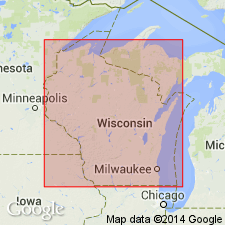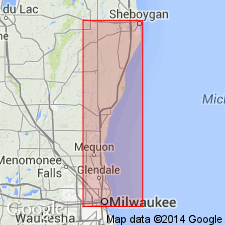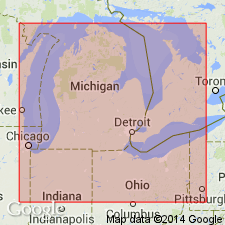
- Usage in publication:
-
- Lake Church formation
- Modifications:
-
- First used
- AAPG geologic province:
-
- Wisconsin arch
Summary:
The position of the provisional Ozaukee and Thiensville formations of Raasch [ms] is to the north, about 30 mi from Milwaukee, occupied by the Lake Church formation (provisional of Raasch), but since the types of animal life in either are entirely distinct they must not be considered as equivalent nor are they contemporary. Although in no place is the complete section of the latter seen, these beds are about 12 ft thick, and from them have come some of the most interesting pelecypods of the region. [Formations are not defined in this report.]
Source: GNU records (USGS DDS-6; Reston GNULEX).

- Usage in publication:
-
- Lake Church formation
- Modifications:
-
- Named
- Dominant lithology:
-
- Dolomite
- AAPG geologic province:
-
- Wisconsin arch
Summary:
Lake Church formation (new) here divided into Ozaukee member above (0 to 27 ft thick) and Belgium member below (0 to 8 ft thick). Underlies Thiensville formation and overlies Racine formation (Silurian). Maximum thickness at least 45 ft. Thins to south by overlap, and disappears in vicinity of Ozaukee-Milwaukee Co. line, where Thiensville formation rests on Silurian. Fossiliferous throughout. Best known, most complete, and most accessible exposure of formation is in and about old Lake Shore stone quarry near Lake Church, Ozaukee Co. Beds referred to by Cleland as Waubakee in the proposed type section are to be included with the Devonian.
Source: GNU records (USGS DDS-6; Reston GNULEX).

- Usage in publication:
-
- Lake Church Formation
- Modifications:
-
- Overview
- AAPG geologic province:
-
- Wisconsin arch
Summary:
Subsurface data suggest that the Lake Church Formation may be a facies (probably II) in the Thiensville, or that the Lake Church at its type may be equivalent to I and II. Raasch (1935) considered the Thiensville to be younger than the Lake Church. Age given here is Middle Devonian (Eifelian?)
Source: GNU records (USGS DDS-6; Reston GNULEX).
For more information, please contact Nancy Stamm, Geologic Names Committee Secretary.
Asterisk (*) indicates published by U.S. Geological Survey authors.
"No current usage" (†) implies that a name has been abandoned or has fallen into disuse. Former usage and, if known, replacement name given in parentheses ( ).
Slash (/) indicates name conflicts with nomenclatural guidelines (CSN, 1933; ACSN, 1961, 1970; NACSN, 1983, 2005, 2021). May be explained within brackets ([ ]).

